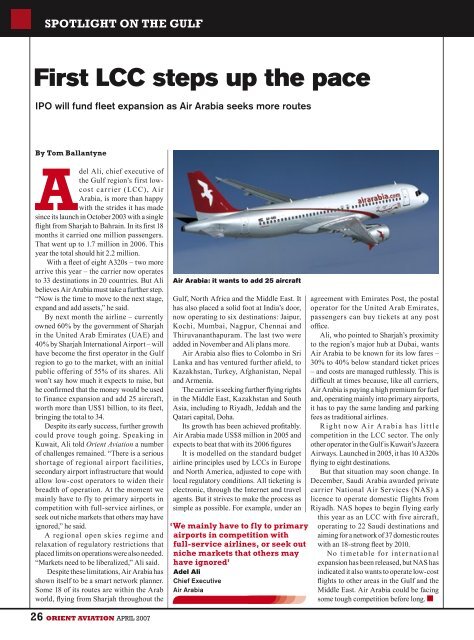Fleet Census - Orient Aviation
Fleet Census - Orient Aviation
Fleet Census - Orient Aviation
You also want an ePaper? Increase the reach of your titles
YUMPU automatically turns print PDFs into web optimized ePapers that Google loves.
SPOTLIGHT ON THE GULF<br />
First LCC steps up the pace<br />
IPO will fund fleet expansion as Air Arabia seeks more routes<br />
By Tom Ballantyne<br />
Adel Ali, chief executive of<br />
the Gulf region’s first lowcost<br />
car rier (LCC), Air<br />
Arabia, is more than happy<br />
with the strides it has made<br />
since its launch in October 2003 with a single<br />
flight from Sharjah to Bahrain. In its first 18<br />
months it carried one million passengers.<br />
That went up to 1.7 million in 2006. This<br />
year the total should hit 2.2 million.<br />
With a fleet of eight A320s – two more<br />
arrive this year – the carrier now operates<br />
to 33 destinations in 20 countries. But Ali<br />
believes Air Arabia must take a further step.<br />
“Now is the time to move to the next stage,<br />
expand and add assets,” he said.<br />
By next month the airline – currently<br />
owned 60% by the government of Sharjah<br />
in the United Arab Emirates (UAE) and<br />
40% by Sharjah International Airport – will<br />
have become the first operator in the Gulf<br />
region to go to the market, with an initial<br />
public offering of 55% of its shares. Ali<br />
won’t say how much it expects to raise, but<br />
he confirmed that the money would be used<br />
to finance expansion and add 25 aircraft,<br />
worth more than US$1 billion, to its fleet,<br />
bringing the total to 34.<br />
Despite its early success, further growth<br />
could prove tough going. Speaking in<br />
Kuwait, Ali told <strong>Orient</strong> <strong>Aviation</strong> a number<br />
of challenges remained. “There is a serious<br />
shortage of regional airport facilities,<br />
secondary airport infrastructure that would<br />
allow low-cost operators to widen their<br />
breadth of operation. At the moment we<br />
mainly have to fly to primary airports in<br />
competition with full-service airlines, or<br />
seek out niche markets that others may have<br />
ignored,” he said.<br />
A regional open skies regime and<br />
relaxation of regulatory restrictions that<br />
placed limits on operations were also needed.<br />
“Markets need to be liberalized,” Ali said.<br />
Despite these limitations, Air Arabia has<br />
shown itself to be a smart network planner.<br />
Some 18 of its routes are within the Arab<br />
world, flying from Sharjah throughout the<br />
Air Arabia: it wants to add 25 aircraft<br />
Gulf, North Africa and the Middle East. It<br />
has also placed a solid foot at India’s door,<br />
now operating to six destinations: Jaipur,<br />
Kochi, Mumbai, Nagpur, Chennai and<br />
Thiruvananthapuram. The last two were<br />
added in November and Ali plans more.<br />
Air Arabia also flies to Colombo in Sri<br />
Lanka and has ventured further afield, to<br />
Kazakhstan, Turkey, Afghanistan, Nepal<br />
and Armenia.<br />
The carrier is seeking further flying rights<br />
in the Middle East, Kazakhstan and South<br />
Asia, including to Riyadh, Jeddah and the<br />
Qatari capital, Doha.<br />
Its growth has been achieved profitably.<br />
Air Arabia made US$8 million in 2005 and<br />
expects to beat that with its 2006 figures<br />
It is modelled on the standard budget<br />
airline principles used by LCCs in Europe<br />
and North America, adjusted to cope with<br />
local regulatory conditions. All ticketing is<br />
electronic, through the Internet and travel<br />
agents. But it strives to make the process as<br />
simple as possible. For example, under an<br />
‘We mainly have to fly to primary<br />
airports in competition with<br />
full-service airlines, or seek out<br />
niche markets that others may<br />
have ignored’<br />
Adel Ali<br />
Chief Executive<br />
Air Arabia<br />
agreement with Emirates Post, the postal<br />
operator for the United Arab Emirates,<br />
passengers can buy tickets at any post<br />
office.<br />
Ali, who pointed to Sharjah’s proximity<br />
to the region’s major hub at Dubai, wants<br />
Air Arabia to be known for its low fares –<br />
30% to 40% below standard ticket prices<br />
– and costs are managed ruthlessly. This is<br />
difficult at times because, like all carriers,<br />
Air Arabia is paying a high premium for fuel<br />
and, operating mainly into primary airports,<br />
it has to pay the same landing and parking<br />
fees as traditional airlines.<br />
R ig ht now A i r A r a bia h a s l it t le<br />
competition in the LCC sector. The only<br />
other operator in the Gulf is Kuwait’s Jazeera<br />
Airways. Launched in 2005, it has 10 A320s<br />
flying to eight destinations.<br />
But that situation may soon change. In<br />
December, Saudi Arabia awarded private<br />
carrier National Air Services (NAS) a<br />
licence to operate domestic flights from<br />
Riyadh. NAS hopes to begin flying early<br />
this year as an LCC with five aircraft,<br />
operating to 22 Saudi destinations and<br />
aiming for a network of 37 domestic routes<br />
with an 18-strong fleet by 2010.<br />
No timetable for inter national<br />
expansion has been released, but NAS has<br />
indicated it also wants to operate low-cost<br />
flights to other areas in the Gulf and the<br />
Middle East. Air Arabia could be facing<br />
some tough competition before long.<br />
26 ORIENT AVIATION APRIL 2007








![OAMag-V7N4-Cover [Converted] - Orient Aviation](https://img.yumpu.com/48598575/1/190x255/oamag-v7n4-cover-converted-orient-aviation.jpg?quality=85)








